
Bison
Riding Mountain National Park
Bison enclosure
GETTING THERE

To access the bison enclosure, visitors must use a motor vehicle.
Visitors can access the area using Lake Audy Road off Highway #10 or Provincial Road #354.
Bison are wild animals. Do not approach them. Do not leave your vehicle. You may be fined.
TO BE OR NOT TO BE…WILD?!
Plains Bison in Riding Mountain National Park

Remembering our history, protecting our future
Riding Mountain National Park (RMNP) has a special area called the Lake Audy Bison Enclosure, which holds a captive herd of approximately 40 plains bison. National Parks are representative of our nation’s natural beginnings; from geological features to different ecosystems. Rare and unique creatures are found within their boundaries. The Plains Bison were absent for some time, but can now be seen on their native prairie once again. Their re-introduction is one step in restoring and protecting the prairie ecosystem.
How the Lake Audy herd came to be

Imagine dark brown specks covering the land as far as the eye can see, their stampeding hooves making the earth shake and the air thunder. In only a few years, this landscape was transformed; the multitude of bison that roamed the plains disappeared. All that remained of their presence was carcasses and bones. This was the fate of the plains bison in Manitoba.
Bison reintroduction was possible because of conservation methods put to work in the early 1900’s. A group of 20 animals from Wainwright, Alberta was re-introduced here in 1931 as a display herd to offer the public the opportunity to view this native creature. A drive over the cattle guards and into the enclosure gives visitors the chance to view bison up-close. A display, depicting the life cycle and history of bison was also built within the enclosure.
The Lake Audy plain was chosen because of its healthy prairie ecosystem; and because old bison bones and markings were found in this area, indicating that this was part of their historic range before their extirpation.
Unfortunately, disaster stuck this first reintroduced herd. The herd had been infected with bovine Tuberculosis while in Alberta, and thus had to be destroyed. It was replaced with 10 plains bison from Elk Island National Park in the 1940s. The bison that roam the enclosure today are descendants of that small group from Elk Island.
The Enclosure
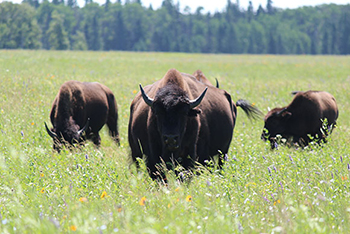
The bison herd roams a 500 hectare enclosure, which is divided into two sections (winter and summer pastures). They are free to roam the enclosure in search of food, water and shelter. A healthy herd is maintained through a park management program. In early-summer the bison are permitted to migrate to the south enclosure. In the fall the herd (except for mature breeding bulls) is moved to the north enclosure.
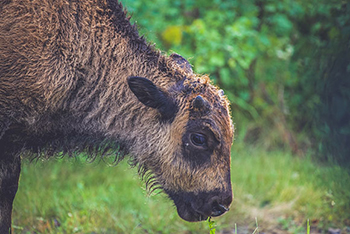
This separation ensures that calving occurs only once a year and that the herd has ample forage for both seasons. Bison play a significant role in the natural processes happening within the rough fescue prairie ecosystem in RMNP. Ensuring their protection as well as the protection of the rough fescue prairie goes hand in hand.
Handling of the Bison
In the fall when the bison are transferred from the south enclosure to the north enclosure, they are lured into a handling facility by bait. Once the herd has moved into this structure they are corralled and tested for common diseases and general health. The capture pen is used year round by the bison as the mineral lick location, this way, luring them to the capture pen is not unsettling.
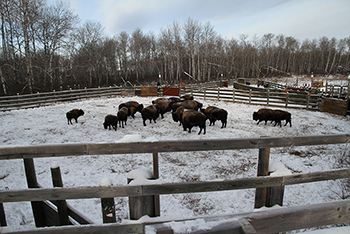
Since the reoccurrence of Bovine Tuberculosis in the area (1991), the bison are tested for this disease every three years. This handling period also allows us to mix the gene pool by removing and replacing bulls. Every few years, when the herd exceeds 50 animals, surplus animals are sold. The enclosed prairie area has been estimated to support a healthy bison herd of around 35-40 animals without doing damage to the grasslands. Removing surplus animals is necessary because their range is limited by the enclosure. The habitat within can only feed so many animals and natural predation, that would control populations, is not occurring.
What about us? There’s a fence in our way!
Many other animals utilise the Lake Audy prairie. Because the fence is not a natural part of the ecosystem, RMNP tries to limit the disturbance that the fence creates to the usual movement of wild animals. “Jumps” (areas where the fence has been pulled down) and “holes” (areas where the fence has been pulled up) have been positioned in multiple places along the fence. Ungulate species such as elk and deer use these areas to access the enclosure for food and shelter. Other mammals, such as bear, coyotes and foxes, use the holes in the fence to come in and out of the enclosure for the same reasons.

What about wolves? A healthy population of wolves is present in RMNP. Historically they are a known predator of bison. In a completely natural setting wolves help maintain bison herds by killing weak, sick and old animals as well as some of the young. This natural selection process ensures that the strong bison will survive and reproduce. Why are the wolves not preying on bison in the enclosure? Wolves are cautious of human structures. The wolves in the Lake Audy area are wary of the fence and rarely venture far into the enclosure. As of yet, they have only preyed on bison on a handful of times, therefore there is a break in the natural cycle. Once again management of the herd becomes necessary. In the future, there are hopes of creating a fence that is less of a psychological barrier to the wolves and possibly reinstating the natural prey-predator interaction between wolves and bison.
Bison for you and me, bison for all to see!
Bison remind us of what our great prairies once resembled, what we have lost and what we must preserve.

Although bison were re-introduced in Riding Mountain National Park as a display herd, today they are valued as much more. Their life cycle is intimately intertwined with the health of the prairie and its other inhabitants. Bison forage on specific grasses, forbs and trees; they create wallows and trails throughout the area; they add nutrients to the soil and they help propagate seeds, therefore contributing to the cycle of life. The importance of this native species is also recognized through the role they played in the development and life of the Indigenous people. Today, the Lake Audy Bison Enclosure is a favourite place for visitors to view bison and to experience the native prairie ecosystem. It remains a crucial area for conservation and education. The bison’s presence can take us back in time when they thundered on Canadian soil in the millions, on the land that is now our backyards, our cities and our parks.
Restoration and Research at Lake Audy
Fascinating things are happening at Lake Audy under the Recovery and Discovery of the Aspen Parkland project, from important restoration initiatives to valuable research that helps us learn more about the rough fescue grassland ecosystem and the effects bison have on it.
SMOOTH BROME CONTROL
You may see evidence of mowing and herbicide application around Lake Audy, which is being done to control smooth brome, an invasive species of grass. By first mowing, and then selectively applying herbicide, we are able to effectively target the smooth brome. This is a multi-year project, and we will continue to monitor the area to determine the effectiveness of the treatment.
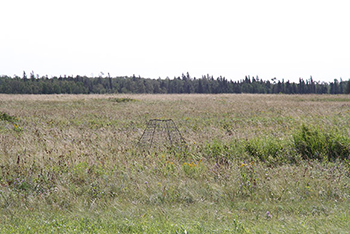
EXCLOSURE EXPERIMENTS
You may notice small cages (exclosures) located throughout the bison enclosure. These are being used to conduct research to help us better manage the bison herd, and better understand the historic role of this large herbivore in other prairies throughout the park. By excluding bison from a small area for a period of time, and comparing the area inside the exclosure to the surrounding area before and after, we are able to measure the effect that bison have on the rough fescue grassland. We are measuring changes in biodiversity, ecosystem function, and the amounts of living and dead vegetation.
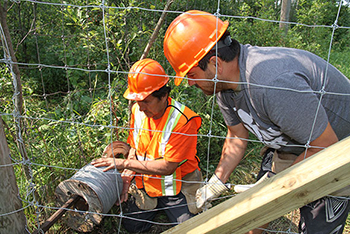
NEW FENCING
Recently, a new section of bison fence was built along Central Trail, which:
- Replaced the existing section of fence in poor repair
- Improved access to the enclosure for wildlife species such as bears, wolves, white-tailed deer, and elk
- Expanded the range of the bison
- Facilitated research on the effect bison have on the encroachment of woody species into the grassland

BISON COLLARING
This past November, six cow bison were fitted with GPS radio-collars. One question you may be asking is, why put collars on bison that live inside a fence? The intent is to record their “micro-movements” as they graze. As such, the collars are set to provide locations at a rate of one location every ½ hour.
The collars, using signals sent to satellites, will help us predict where bison would spend their time, and what they would eat, if they were allowed to expand their range outside the current bison enclosure.
This work is done in cooperation with the University of Saskatchewan and members of the Keeseekowenin Ojibway First Nation.
- Date modified :